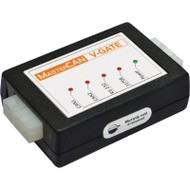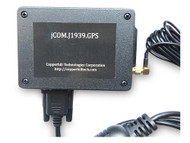Product Description
Free Shipping Within the United States!
Unleash the power of the Arduino Due with ARM Cortex-M3 processor to develop and test your SAE J1939 application, may it be an SAE J1939 to USB protocol converter, an SAE J1939 Bridge, an SAE J1939 data monitor, and many more. The SAE J1939 Programming Kit comes with many programming samples, including a full-blown SAE J1939 protocol stack (ARD1939). The included SAE J1939 Simulator Board serves as a transmitter and receiver of SAE J1939 data frames (PGNs). Use the Windows-based jCOM1939 monitoring and simulation software to display, record, or transmit J1939 PGNs, including data request messages. To top things up, the kit includes two books on the SAE J1939 Standard and Arduino Programming for J1939 applications.
While the book's focus is on the Arduino Uno and Mega 2560, the documentation also applies to our SAE J1939 protocol stack for the Arduino Due.
See: SAE J1939 Protocol Stack Sketch for Arduino Due.
Please be aware that the Arduino Due is specified for an operational temperature range of 0 to 50C - 32 to 122F.
Content of Delivery:
- Arduino-Due-Based ECU Development Board with Dual CAN Bus Interface...
- SAE J1939 ECU Simulator Board With USB Port...
- jCOM1939 Monitor - SAE J1939 Monitor, Analyzer, And ECU Simulator...
- 2 x USB cables for Arduino and J1939 Simulator
- 12 VDC Switching Power Supply
- Book: A Comprehensible Guide to J1939...
- Book: SAE J1939 ECU Programming & Vehicle Bus Simulation with Arduino...
Please refer to the above links for more detailed information.
The Arduino Due board is one of the most powerful development boards in the ARDUINO series. The DUE board comes with tons of features; it also has terrific processing speed making it suitable for advanced applications. The DUE can be considered as the professional board considered, where the UNO is the beginner board. The DUE board was also developed with the ARM controller series, a high-performance processor, whereas the other boards are based on the ATMEGA controller series.
The Due Core board is powered either by the USB port connection (either the programming or native USB) or through an external power supply supporting an input voltage of 7 to 36 VDC.
Possible applications include:
- CAN to USB Gateway and Protocol Converter
- SAE J1939 Gateway and Protocol Converter
- CAN Data Logger
- CAN Bridge (connecting 2 CAN networks, even at different baud rates)
- CAN Analyzer (in combination with a suitable Windows program)
- SAE J1939 Data Monitoring
- CAN ECU Prototyping
- SAE J1939 ECU Prototyping
Quick-Start Guide
Trouble-Shooting:
If you experience any problems with running our program samples, please check the following:
- Make sure, your Arduino IDE supports the Due - See: Arduino Due IDE Setup
- Make sure, you have the newest version of the Arduino IDE installed
CAN Board Resources:
- Arduino Due: Dual CAN Port Test Sketch
- Arduino Due: Dual CAN Port Test Sketch With LED CAN Traffic Indicators
- Dual CAN Bus Interface For Arduino Due: Controlling the LEDs
- ODB2 and CAN Bus Acquisition Libraries
- SAE J1939 Protocol Stack Sketch for Arduino Due
- App Note: ARM Cortex M3 Development Boards Require External CAN Bus Transceiver
- CAN Bus Data Traffic Simulation With Arduino Due
- CAN Bus Bridge (CAN-to-CAN) Application With Arduino Due
- SAE J1939 GPS Application With Arduino Due Delivers PGN 65267 (Vehicle Position)
- SAE J1939 250k/500k Baudrate Converter with Arduino Due - Source Code Included
Arduino Due Resources:
- Getting started with the Arduino Due...
- Download the Arduino Software (IDE)...
- Arduino Due Pinout, Configuration, and Features...
- Atmel 11057 32-bit Cortex-M3 Microcontroller SAM3X/SAM3A Datasheet (PDF...)
- A Brief Introduction to Controller Area Network...
- Arduino Due Firmware Flaw: Problem With Using The USB Programming Port At 230400 Baud And Beyond...
- ARM Cortex Processors – UART Programming Problem At Baud Rates Higher Than 115200...
- Arduino Due - Programming And Debugging Using JTAG ICE And Atmel Studio...
More Resources
- Arduino DUE CORE Board With Dual CAN Bus Interface And Extended Power Supply Range...
- Programmable, Arduino-Due-Based USB Gateway With Two CAN Bus Ports...
Programming Arduino - Getting Started With Sketches
by Simon Monk
 Clear, easy-to-follow examples show you how to program Arduino with ease! "Programming Arduino: Getting Started with Sketches" helps you understand the software side of Arduino and explains how to write well-crafted Sketches (the name given to Arduino programs) using the C language of Arduino. This practical guide offers an un-intimidating, concise approach for non-programmers that will get you up and running right away.
Clear, easy-to-follow examples show you how to program Arduino with ease! "Programming Arduino: Getting Started with Sketches" helps you understand the software side of Arduino and explains how to write well-crafted Sketches (the name given to Arduino programs) using the C language of Arduino. This practical guide offers an un-intimidating, concise approach for non-programmers that will get you up and running right away.
Programming Arduino: Getting Started with Sketches explains basic concepts and syntax of C with simple language and clear examples designed for absolute beginners - no prior knowledge of programming is required. It leads you from basic through to advanced C programming concepts and features dozens of specific examples that illustrate concepts and can be used as-is or modified to suit your purposes.
- All code from the book is available for download.
- Helps you develop working Sketches quickly.
Coverage includes: C Language Basics; Functions; Arrays, Strings; Input / Output; Standard Library Goodies; Storage; LCD Displays; Programming for the Web; Program Design; C++ and Library Writing
 Loading... Please wait...
Loading... Please wait...











